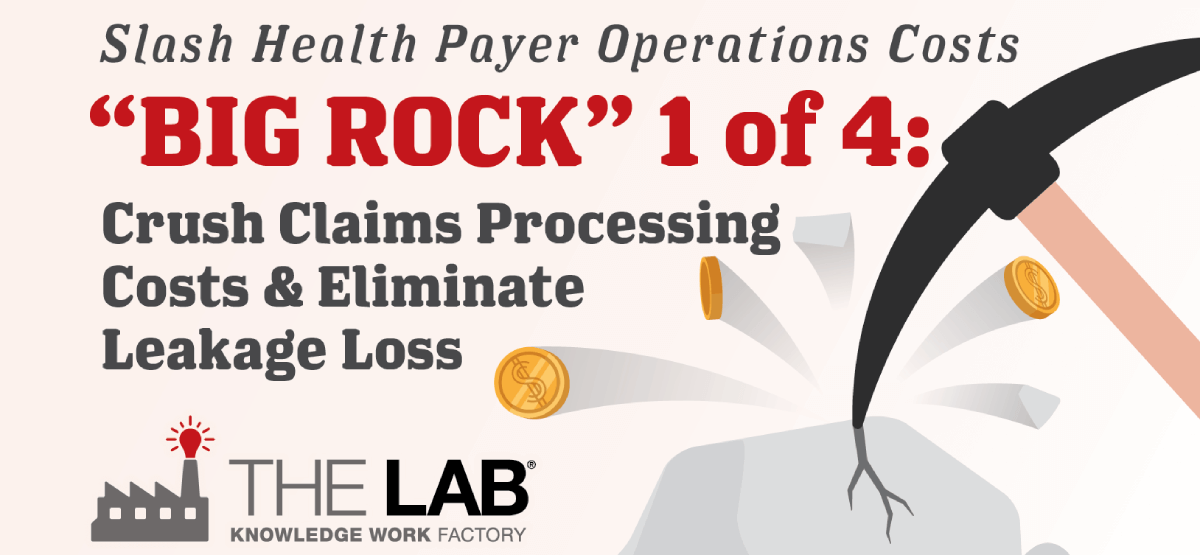Half of your operation’s cost-saving potential hides here
The goal of effective healthcare is timeless; only the approach and technologies change. Whether it’s the broader strategy of population health management (PHM) or the more tactical value-based care (VBC), better health outcomes for patients also equate to better financial outcomes for payers, administrators, and providers in the form of lower and more effective costs.
But here’s an approach that’s persistently overlooked: Standardization. Standardized work is easier to digitize, automate, and analyze. And it’s a prerequisite for successful VBC and PHM.
Better yet, it’s a surprisingly accessible opportunity, for health plans of virtually any size. And it can yield transformational business improvements in as little as six months.
Standardization also paves the way for advanced analytics and automation.

The benefits of standardization play a lead role in each of the “big rock opportunities” which health plans continually confront—the focus of this series of articles:
- This article: Big Rock 1: Crush Claims Processing Costs & Eliminate Leakage Loss. 50% of the savings resides here.
- Big Rock 2: Slash Member Services Costs & Improve Member Experience. 20% of the savings—and most member-experience gains—reside here.
- Big Rock 3: Crush Medical Management Costs & Turbocharge Effectiveness. 20% of the savings—and the 1st half of the effectiveness gains—reside here.
- Big Rock 4: Streamline Provider Services & Improve Network Effectiveness. 10% of the savings, 2nd half of effectiveness.
Let’s see how this power can slash costs and turbocharge effectiveness in claims.
Claims cost-crushing: Begin by broadening your perspective
“Claims” entails a lot more than examiners. If you really want to slash claims costs—while improving claim-processing productivity—you need to first expand the operational “footprint” of claims to include:
- Submission/intake
- Assignment
- Eligibility review
- Adjustment (leakage loss alert!)
- Denials management
- Payment
- Subrogation
- Audit/QC
This article will address several of these—each of which can deliver massive cost-cutting and effectiveness-boosting benefits.
Cost-cutting for submission: Identify—and separate—“lift” from “drag”
Given that the average claim form contains more than 250 fields, claims submission is the initial step of the process in which things, unfortunately, take a turn for the worse—and the more costly. Submitters code claims using insufficiently detailed guidelines—and often submit them via blurry fax machines!
Looking for a quick fix? Simply analyze errors by individual provider group or claims examiner. Odds are you’ll discover a small number of “repeat offenders” who generate the most errors.

Employing the “Lift/Drag” strategy
To reduce claims-submission errors, you want to first identify the “ideal” coding performers and work activities—the far-left side of the diagram below. Those are the ones you’ll want to emulate and “clone.” Just to the right of those, are the not-so-productive performers whom you’ll want to raise to the level of their best-practice peers.

Now look at the right side—the red side—of that diagram. That’s the “drag” on your submission engine. Those are all the performers, provider groups, and their work activities—maddening once you spot them—that are sucking the life, and the margin, out of your claims operation. Drill down within each group and you’ll find the same for individual performers! Consider:
- “NIGO” creates a rework factory. Employees perform—and perfect—the tedious tasks of correcting the same submission errors, over and over. The squandered labor cost of this hidden “factory” is frequently 50 percent of examiner capacity. Excluding the negative impact on “experience” for both members and providers, the downstream costs related to things like forms and fields submitted “not in good order” or NIGO, can be staggering—often with tens (even hundreds) of millions of dollars in over-paid and under-recouped losses flying straight past your imprecise managerial radar.

- “False Precision”: How simple becomes complex. The Lab’s experience shows that, once error categories are standardized, as few as three top errors typically account for the vast majority of total errors—and this holds true for both providers and examiners.

- Standardized tools can control errors. Don’t let each person have their own “method.” Standardized tools can rein in this problem. Providers need claims-coding and submission-accuracy job aids, prior-authorization lists, etc. Examiners can benefit from common adjustment-error FAQs, eligibility “cheat sheets,” and graphic illustrations.
Cost-cutting for claims examiner productivity: Identify—and separate— “lift” from “drag”
Claims operations performance is typically reported in the form of averages, for work teams or organizations. Yet individual examiners’ performance is rarely measured, compared, benchmarked, or managed.
Look at the chart below. The Lab will often spot more than a ten-fold spread in productivity rates, among different adjusters, processing identical claims.

Addressing this one issue often yields a 15- to 20-percent capacity lift. And that’s before we get to claims “leakage.”
Cutting losses from claims leakage: Identify—and separate—“lift” from “drag”
This is the biggest eye-opener for payer executives. When The Lab uncovers claims leakage from claims adjustment failures—that is, overpayment of claims by individual examiners—their blood pressure skyrockets. But then, they act.

Hard data—in the form of business intelligence (BI) dashboards—is a powerful tool here. Just look at the graphic below: a 4x variance in payments for identical X-ray procedures at the IPA level—and an 6x variance at the individual-provider level!

It’s not just BI to the rescue. The Lab can—and does—install special robots that monitor the activities of individual examiners, proactively reporting their payment (and denial) activity, compared to your own historical baselines, so that you can take cost-cutting action before it’s too late.

Suffice to say, this one subcategory of claims-leakage loss reduction typically delivers benefits in the tens of millions of dollars within just weeks of implementation.
Slash those medical claims costs now
If you’re looking to crush claims-processing costs and eliminate leakage loss, you need to get onto a screen-sharing demo with The Lab right now. In just 30 minutes, we’ll show you how we’ve saved countless other payers hundreds of millions in claims costs—and how we can help you, too.
Simply contact The Lab at (201) 526-1200 or info@thelabconsulting.com today!

















